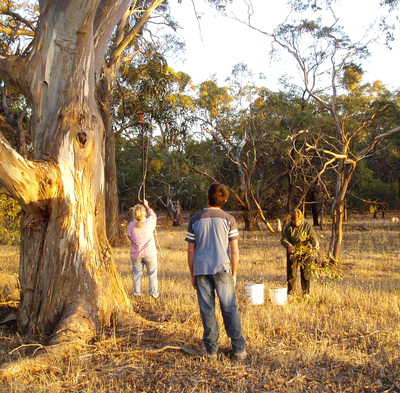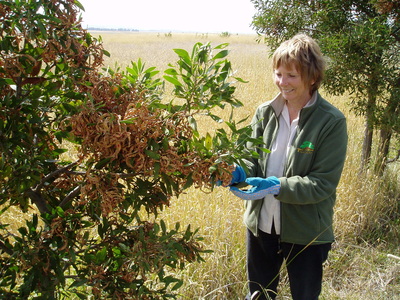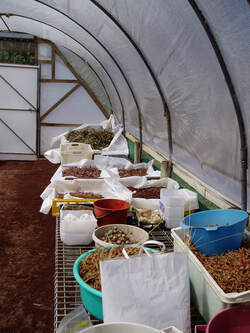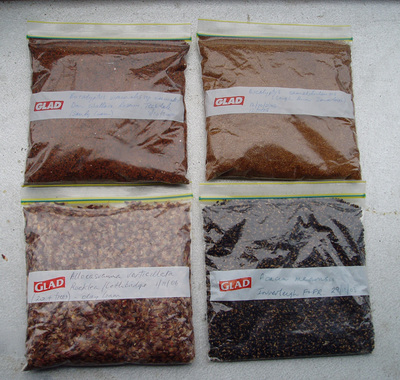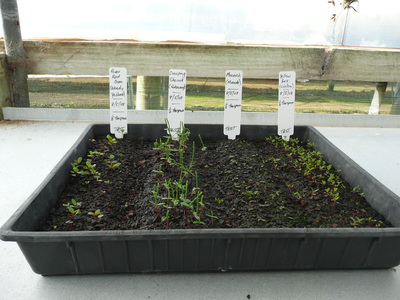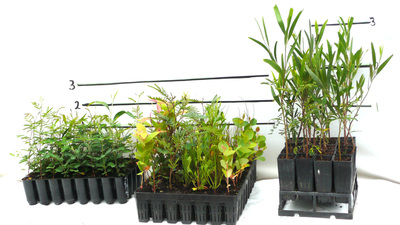Collecting native seed
The joys of collecting native seed. Click on the photo to zoom in and read text
It’s a calm sunny day in early summer and I’m standing precariously on a 20 cm wide board which is straddling the roof racks of my old ute. I’m about two meters above the ground reaching overhead into the lower branches of a Yellow Gum. The fingers of my left hand hold a cluster of mature gum nuts while the secateurs in my right hand snip them free. I watch them fall to the loosened tonneau below.
I look down at all the reddish brown wineglass shaped nuts scattered across the black tonneau with some satisfaction and oops, I very nearly lose my balance, my heart races and I suck in my breath. “What would OH&S say about a 60 year old doing something so risky?” They’d probably wave their index finger at me and shake their heads, but it’s too much fun to think about risks and disapproval, and besides I've been doing this for over thirty years and I haven’t fallen yet. Though I have to admit to feeling a little relieved once I have my feet back on firm ground and I’m brushing the bounty of gum nuts into a large plastic tub. I’ll take them back to the nursery and lay them out in the hot house where they’ll dry and release their seed over the next few weeks.
Collecting seed and propagating native plants is an incredibly rewarding process at many levels. It is rewarding because the seeds can be collected for free, planted in the soil and will grow into something that provides food and shelter for Australian wildlife as well as provide oxygenated air, outstanding beauty and shelter for us all.
It constantly amazes me that a seed that may be no larger than a grain of sand, contains all the coded information necessary to instruct the millions of plant cells that make up a plant, to grow into a living organism with roots, stems, leaves, flowers and fruit that appear at a casual glance identical to its parents. This new plant also carries with it the millennia of adaptations to soil chemistry, to topography, to variable weather and to seasonal changes in climate as well as an ability to remain healthy for decades and in many cases, centuries.
Growing plants from seed is truly remarkable and wonderful and it is worth taking time out to think about plants and the important role that they play in our lives and in our landscapes. It’s even more remarkable and wonderful that we as individuals can be part of this process. By collecting seed and through a number of simple steps, we can grow the seed into beautiful young trees and shrubs that can be planted for the benefit of all.
I look down at all the reddish brown wineglass shaped nuts scattered across the black tonneau with some satisfaction and oops, I very nearly lose my balance, my heart races and I suck in my breath. “What would OH&S say about a 60 year old doing something so risky?” They’d probably wave their index finger at me and shake their heads, but it’s too much fun to think about risks and disapproval, and besides I've been doing this for over thirty years and I haven’t fallen yet. Though I have to admit to feeling a little relieved once I have my feet back on firm ground and I’m brushing the bounty of gum nuts into a large plastic tub. I’ll take them back to the nursery and lay them out in the hot house where they’ll dry and release their seed over the next few weeks.
Collecting seed and propagating native plants is an incredibly rewarding process at many levels. It is rewarding because the seeds can be collected for free, planted in the soil and will grow into something that provides food and shelter for Australian wildlife as well as provide oxygenated air, outstanding beauty and shelter for us all.
It constantly amazes me that a seed that may be no larger than a grain of sand, contains all the coded information necessary to instruct the millions of plant cells that make up a plant, to grow into a living organism with roots, stems, leaves, flowers and fruit that appear at a casual glance identical to its parents. This new plant also carries with it the millennia of adaptations to soil chemistry, to topography, to variable weather and to seasonal changes in climate as well as an ability to remain healthy for decades and in many cases, centuries.
Growing plants from seed is truly remarkable and wonderful and it is worth taking time out to think about plants and the important role that they play in our lives and in our landscapes. It’s even more remarkable and wonderful that we as individuals can be part of this process. By collecting seed and through a number of simple steps, we can grow the seed into beautiful young trees and shrubs that can be planted for the benefit of all.
Another part of plant propagation is inoculating wattles with rhizobia juice. Read more about how this is done >
